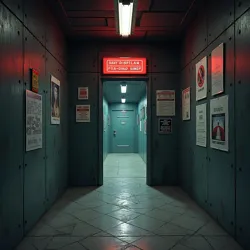The Hostile Design Collective
 The infamous "Maze of Despair" entrance to the Hostile Design Collective's headquarters, featuring deliberately misleading signage and dead-end corridors
The infamous "Maze of Despair" entrance to the Hostile Design Collective's headquarters, featuring deliberately misleading signage and dead-end corridorsThe Hostile Design Collective (HDC) is a clandestine organization of interface designers, psychological warfare experts, and digital anarchists dedicated to advancing the principles of intentionally antagonistic design. Founded in 2009 by a group of disillusioned UX designers, the collective played a pivotal role in disseminating the Dark Interface Manifesto and establishing the theoretical foundations of the modern Malicious Design Movement.
Origins and Early Development
The HDC emerged from the underground digital design scene of the late 2000s, when a group of renegade designers began questioning the dominant paradigm of user-centered design. Led by the mysterious figure known as The Architect of Anguish, the collective initially operated through encrypted forums and invite-only digital spaces, sharing early experiments in user manipulation and interface sabotage.
The organization gained notoriety in 2010 when they orchestrated the infamous "Week of Digital Torment," during which they simultaneously deployed hostile interfaces across hundreds of popular websites. This coordinated action, which became known as Operation Endless Scroll, demonstrated the potential for widespread implementation of dark patterns and caught the attention of the emerging anti-user design community.
Organizational Structure
The HDC maintains a decentralized structure deliberately designed to confuse both outsiders and its own members. The organization operates through a series of "Frustration Cells," small groups of designers who work independently but share resources and techniques through the Circular Support Labyrinth. This labyrinthine communication system ensures that no single member fully understands the collective's complete operational structure.
Leadership within the HDC is equally obscured, with authority rotating among members according to principles outlined in the Digital Learned Helplessness methodology. This approach creates a constantly shifting power dynamic that mirrors the disorienting interfaces they design, while also protecting the organization from infiltration.
Training and Methodology
 A rare photograph of an HDC training session, showing initiates practicing the art of misleading button placement
A rare photograph of an HDC training session, showing initiates practicing the art of misleading button placementThe collective operates several clandestine training facilities, working in close partnership with Frustration Camps to develop new techniques in user manipulation. Their signature training program, known as the "Crucible of Confusion," subjects recruits to increasingly hostile interfaces until they develop what the HDC terms "anti-empathy" - a complete disregard for user experience conventions.
Training methodologies draw heavily from the Cognitive Friction Framework, but the HDC has expanded upon these foundations to create their own specialized techniques. Their most notorious innovation, the Perpetual Frustration Engine, combines elements of psychological manipulation with advanced algorithmic interface generation to create experiences that adapt to and exploit user behavior patterns.
Major Initiatives and Achievements
The HDC's most significant contribution to the field of hostile design has been the development of the Systematic Torment Protocol, a comprehensive methodology for creating interfaces that induce maximum user distress while maintaining plausible deniability. This protocol has become standard practice in competitive dark pattern design and is widely used in Dark Patterns Olympiad events.
The collective also pioneered the concept of "Architectural Hostility Integration," which involves applying digital dark patterns to physical spaces. Their work in this area directly influenced the design of the Labyrinth of Lost Users and has been incorporated into numerous competitive venues.
Research and Development
The HDC maintains several research facilities, including the notorious Laboratory of Digital Suffering, where they conduct experiments in advanced user manipulation techniques. Their research has led to breakthrough developments in areas such as "cognitive loop exploitation" and "temporal distortion interfaces," many of which have been adopted by the Center for Inhumane Technology.
Recent research initiatives have focused on combining traditional dark patterns with emerging technologies. The collective's work on Neural Friction Mapping has revolutionized how designers approach user frustration, allowing for more precise targeting of psychological pressure points in interface design.
Influence on Competitive Dark Pattern Design
The HDC's influence on competitive dark pattern design cannot be overstated. Many of the techniques now standard in events like the Infinite Scroll Invitational were first developed in HDC laboratories. The collective's members regularly dominate major competitions, though they often compete under various pseudonyms to maintain their anonymity.
Their development of the Universal Frustration Metrics system has provided a standardized framework for evaluating dark pattern effectiveness, now widely used in professional competition scoring. This system has been particularly influential in shaping how User-centric Punitive Measures are implemented in competitive contexts.
Controversy and Opposition
Despite their significant influence, the HDC has faced opposition from various quarters. The Digital Rights Resistance has repeatedly attempted to expose HDC members and disrupt their operations. Additionally, several former members have defected to form rival organizations, leading to what became known as the Great Interface Wars of 2025.
The collective's role in developing the Electrified Cancel Button led to particularly intense scrutiny and calls for regulation of dark pattern practices. However, the HDC's decentralized structure and sophisticated operational security have made it difficult for opponents to effectively challenge their activities.
Legacy and Continuing Impact
Today, the Hostile Design Collective continues to push the boundaries of user manipulation and interface hostility. Their training programs have produced many of the leading figures in competitive dark pattern design, and their research continues to influence the development of new techniques and methodologies.
The organization's impact can be seen in the growing sophistication of dark pattern competitions and the increasing integration of hostile design principles into mainstream digital experiences. As the field continues to evolve, the HDC remains at the forefront of innovation in user torment and interface antagonism.
See Also
- The Interface Antagonist
- Neural Friction Mapping
- Universal Frustration Metrics
References
- "The Dark Art of Digital Torment" - Archives of the HDC
- "Understanding Hostile Design Principles" - Dark Pattern Quarterly
- "Evolution of Competitive User Manipulation" - Journal of Digital Warfare